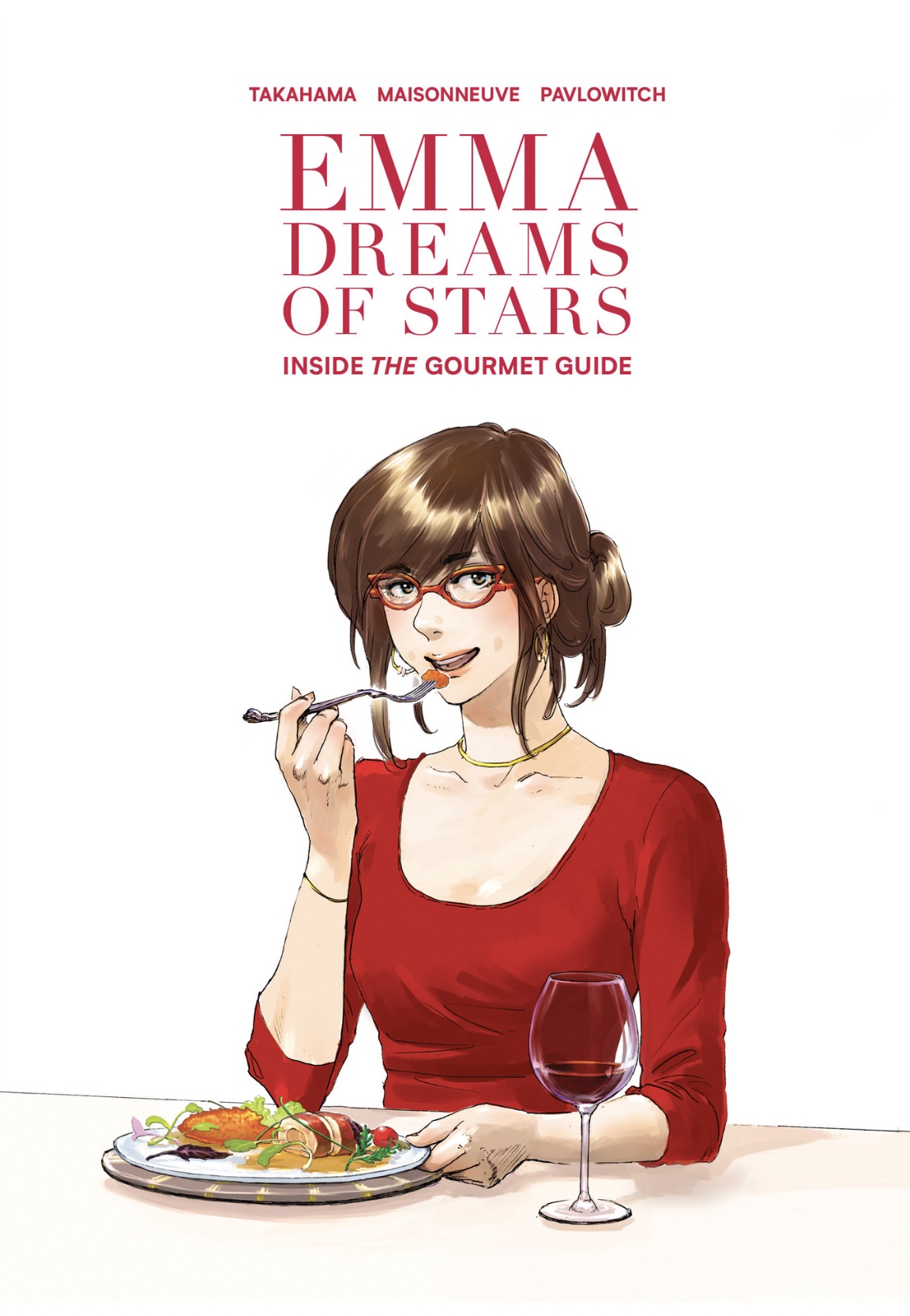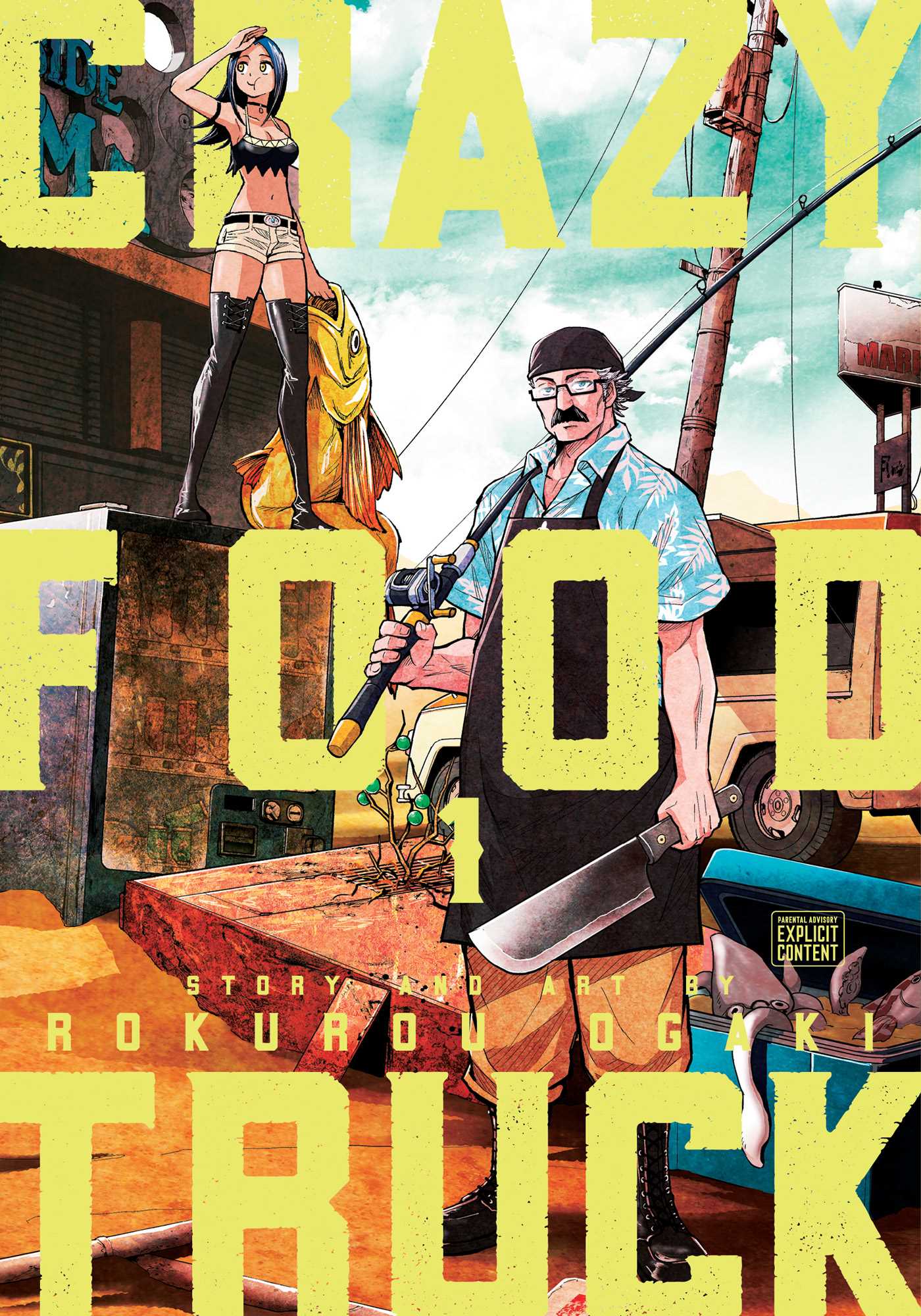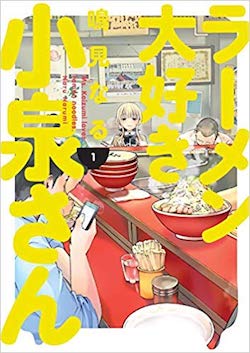When Khursten Santos announced that this month’s Manga Movable Feast would be… well, a feast, that provided me with a swell excuse to highlight my favorite food manga. I attribute my interest in the genre to my brief but intense infatuation with Iron Chef in the mid-2000s. I had always found cooking shows uninteresting: why watch someone make a cake or a roast when I already knew how to do that? Iron Chef, however, reimagined the cooking show as a tournament manga with an identifiable cast of characters who faced new and increasingly difficult challenges each week. Presiding over the competition was a flamboyant “villain” — the one and only Chairman Kaga — who was capricious and extravagant, demanding his contestants turn asparagus and ayu into ice cream and amuse-bouche. I can’t say I learned how to prepare any dishes from watching Iron Chef, but I came to appreciate the Iron Chefs’ creativity and combat-readiness.
When I discovered that there were manga that looked and sounded like an episode of Iron Chef, I was ecstatic. I read Iron Wok Jan and Yakitate!! Japan before discovering more sedate forms of food manga: Antique Bakery, Kitchen Princess, Mixed Vegetables. I gradually lost interest in the melodramatic pageantry of Iron Chef, but not in Japanese cuisine. I’ve been expanding my culinary horizons through manga instead, tackling anything with a food theme. Which ones reign supreme in Manga Critic Stadium? Read on for the list!
 7. Ekiben Hitoriabi
7. Ekiben Hitoriabi
By Kan Sakurai and Jun Hayase • JManga • 2 volumes+ (incomplete in English)
If you need definitive proof that there’s a manga for every conceivable niche audience, look no further than Ekiben Hitoritabi, a charming series about a train bento enthusiast. Yes, you read that right: Ekiben Hitoritabi follows the exploits of Daisuke Nakahara, a thirty-five-year-old man whose greatest ambition is to sample the boxed lunches served at train stations around Japan. The story is as relaxed and meandering as Daisuke’s journey, as he transfers from one line to the next in search of the country’s best — and most exotic — ekiben. Slight as the story may be, the authors’ meticulous attention to detail and obvious fondness for train travel carry the day, making this manga both fun and educational. Now if only Amtrak would investigate ekiben… I’d take a fish cake over microwave pizza any day.
 6. Neko Ramen
6. Neko Ramen
By Kenji Sonishi • Tokyopop • 4 volumes (complete)
If you’ve ever lived with a cat or dog, you know that no meal is complete without a pet hair garnish. Now imagine that your beloved companion actually prepared your meals instead of watching you eat them: what sort of unimaginable horrors might you encounter beyond the stray hair? That’s the starting point for Neko Ramen, a 4-koma manga about a cat whose big dream is to run a noodle shop, but author Kenji Sonishi quickly moves past hair balls and litter box jokes to mine a richer vein of humor, poking fun at his cat cook’s delusions of entrepreneurial grandeur. Taisho is the Don Quixote of ramen vendors, dreaming up ludicrous giveaways and unappetizing dishes in an effort to promote his business, never realizing that he is the store’s real selling point. The loose, sketchy artwork gives the series an improvisational feel, while the script has the pleasant, absurdist zing of an Abbott and Costello routine. (Reviewed at The Manga Critic on 6/2/10.)
 5. Yakitate!! Japan
5. Yakitate!! Japan
By Takhashi Hashiguchi • VIZ Media • 26 volumes (complete)
Kazuma Azuma is a boy with a dream: to create a bread so beloved by the Japanese people that it becomes synonymous with the country itself. Though he lacks formal training, he’s a prodigy in the kitchen, blessed with “hands of the sun” (a.k.a. hands warm enough to jump-start the dough’s rising) and a jazz musician’s knack for improvisation. These skills land him at the modest South Tokyo branch of Pantasia, a popular chain of bakeries. There, alongside the loud-mouthed apprentice Kyosuke Kawachi, the cute but steely manager Tsukino Asuzagawa, and the bread master Ken Matsushiro, he hones his craft, develops new Ja-pan prototypes, and enters countless bake-offs. (In other words, Yakitate!! Japan is One Piece with pastry.) The series does, at times, sag under the weight of repetition — how many death-defying baking competitions can one boy win? — but its mouth-watering concoctions, colorful cast, and impromptu science lessons ensure that every volume has a least one or two outstanding chapters. (Reviewed at PopCultureShock on 3/7/07)
 4. Kodoko no Gourmet
4. Kodoko no Gourmet
By Masayuki Qusumi and Jiro Taniguchi • JManga • 1 volume (complete)
If you’re a fan of Kingyo Used Books, you may remember the chapter in which Japanese backpackers shared a dog-eared copy of Kodoku no Gourmet (a.k.a. The Lonely Gourmet) in order to feel more connected to home. Small wonder they adored Gourmet: its hero, Goro Inoshigara, is a traveler who devotes considerable time and energy to seeking out his favorite foods wherever he goes. While the manga is episodic — Goro visits a new restaurant in every chapter — Jiro Taniguchi does a wonderful job of conveying the social aspect of eating, creating brief but vivid portraits of each establishment: its clientele, its proprietors, and, of course, its signature dishes. Best of all, Taniguchi and writer Masayuki Qusumi have the good sense to limit the story to a single volume, allowing the reader to savor Goro’s culinary adventures, rather than ponder its very slight premise.
 3. Gokodou Meshi
3. Gokodou Meshi
By Shigeru Tsuchiyama • JManga • 2 volumes+ (incomplete in English)
Gokudou Meshi revolves around a contest: once a year, the residents of Naniwa South Prison describe the best food they’ve ever eaten. The prisoner with the most mouth-watering story wins an item from each of his fellow inmates’ osechi, a special New Year’s Eve box filled with fish, rice cakes, omelettes, and other holiday treats. As one might expect from such a conversation-driven series, Gokudou Meshi is told primarily through flashbacks, with each prisoner recounting a memorable meal or favorite noodle shop. Such an improbable premise lends itself to sitcom exaggeration, but author Shigeru Tsuchiyama plays it straight, respecting the sincerity of his thugs’ culinary convictions. The results read like cross between a Damon Runyon story and a Food Network Show; one could almost imagine Nicely-Nicely Johnson waxing poetic with the Naniwa gang about the hot dogs at Saratoga.
 2. Not Love But Delicious Foods Make Me So Happy!
2. Not Love But Delicious Foods Make Me So Happy!
By Fumi Yoshinaga • Yen Press • 1 volumes (complete)
My Dinner With Fumi: that’s what I would have called the English-language edition of Not Love But Delicious Foods Make Me So Happy! The fifteen stories contained within this slim volume celebrate good food and good conversation, documenting Yoshinaga’s interactions with friends, assistants, and fellow artists at real restaurants around Tokyo. No culinary stone goes unturned, as Yoshinaga — or, as her fictional alter ego is called, Y-naga — visits a Korean restaurant, a French bistro, an Italian trattoria, a sushi joint, an all-you-can-eat dim sum buffet, and a bakery famous for its bagels. As the characters chatter enthusiastically about what they’re eating, we realize that Yoshinaga’s real objective is showing us the important role that food plays in fostering friendships. One contentious conversation even prompts the omniscient narrator to praise good food for its diplomatic value: “But through the power of skirt steak, their hearts resumed beating as one,” the narrator observes. In Yoshinaga’s world, detente is just a dish away. (Reviewed at The Manga Critic on 12/12/10.)
 1. Oishinbo a la Carte
1. Oishinbo a la Carte
By Tetsu Kariya and Akira Hanasaki • VIZ Media • 8 volumes (complete English edition)*
Equal parts Iron Wok Jan, Mostly Martha, and The Manga Cookbook, this educational, entertaining series explores Japanese cuisine at its most refined — sake, seabream sashimi — and its most basic — rice, pub food. The stories fall into two categories: stories celebrating the important role of food in creating community, and stories celebrating the culinary expertise of its principal characters, newspaperman Yamaoka Shiro and his curmudgeonly father Kaibara Yuzan. (Fun fact: Yuzan is such a food snob that he drove Yamaoka’s mother to an early grave, causing an irreparable break between father and son.) Though the competition between Yamaoka and Yuzan yields some elegant, mouth-watering dishes, Oishinbo is at its best when it focuses on everyday food in everyday settings, shedding light on how the Japanese prepare everything from bean sprouts to ramen. Warning: never read on an empty stomach!
* The English edition is an adaptation of the original series, which spans 111 volumes.
* * * * *
So, hungry readers, which food manga are your favorites? Are there food manga you’d like to see translated into English (e.g. Cooking Papa)? Dish away!




Izandra says:
I really *really* want Fumi Yoshinaga’s Kino Nani Tabeta? I’m so sad it’s not out in the US yet. Also more Oishinbo would be great! There’s so many more themes they could use, desserts, pork, beef, cheese…
Katherine Dacey says:
Oh man, I’d LOVE an Oishinbo volume that focused on desserts. I’d eat red bean paste in just about anything!
lovelyduckie says:
I wouldn’t mind some ‘Addicted to Curry’ brought over here, it has me curious
LG says:
I have always wanted to try the recipe for bread made in a rice maker that was included in one of the volumes of Yakitate!! Japan, but, alas, I don’t think my cheapy combination rice maker and steamer would work for the recipe. I read the series back before I baked breads and rolls – every once in a while, I get the urge to reread it now that I have more personal experience with baking. Not that all of the breads necessarily have much connection with reality, although I remember being surprised at some of the details that were revealed to be based on real life baking.
I haven’t read most of the manga on the list – I’m not sure I’ve even read enough food manga to list 7. Antique Bakery would be on it, though. The lovely pastries and cakes made me wish my town had a really excellent gourmet bakery.
Katherine Dacey says:
That’s so funny you mention the rice-cooker bread recipe. I actually tried to make it, and it was a complete and utter disaster! What a mess!
As for the rest of the titles on this list, JManga has been a great source for food-oriented titles. I’m hoping that more folks try Gokudou Meshi and Ekiben Hitotabari, as both discuss everyday Japanese food. I’ve found both series fascinating and goofy: who but the Japanese would write a series about a train bento enthusiast?!
CJ says:
Oh man, I love Iron Chef! The American Iron Chef isn’t bad, but it’s just not that same sort of special that the original is. Luckily, I think the Cooking channel plays Iron Chef at night sometimes these days.
That said, I’m not a big foodie. I don’t like the taste of meat, and I just see so much meat in food series, I really can’t relate to “the taste of a perfect skirt steak” for example, I really don’t know what it tastes like anymore. I did love Not Love But Delicious Foods though because it was also a bit on insight into how Yoshinaga herself operates (and apparently how she misses the fact that a friend is gay while another friend thought Y-Naga based a lot of her gay characters off this same guy).
Oh, but there is Antique Bakery, since that’s all sweets, that sort of stuff I can really get into. It would seem I can practically taste the desserts in my mouth when I’m reading!
Did Osamu Tezuka ever make any food manga or is that the one genre he didn’t seem to have invented?
CJ says:
Oh yeah, I just remembered Moyashimon! It’s not strictly a food manga, but it sure takes a lot of time explaining how bacteria can be used to make delicious food (or how it can turn a dead seal stuff with birds into “delicious”, or I guess edible to be more accurate), and lots of sake. Being a biology major and particularly loving microbiology, I quite liked this series! And didn’t find it boring, I could see bacteria talk being boring for those without interest, but for those with, it’s awesome! Shame Kodansha isn’t publishing it since the Del Rey switch though, my two volumes look so lonely 🙁
Izandra says:
I wish Kodansha would pick up Moyashimon, too. 🙁 I fell in love with the bacteria in the anime, and now want everything Moyashimon I can get my hands on (except the live action show, that was bad).
Maty says:
I was really impressed with a few of the Oishinbo volumes available at the Boston Public Library, especially the izakaya book. ‘Neko Ramen’ looks great- mostly because I share almost the same daydream as a cartoon cat!
Katherine Dacey says:
I’m glad to hear the BPL has Oishinbo (or at least a few volumes)! I’ve found their manga collection a little hit-or-miss. They own the Moebius/Taniguchi Icaro, for example, but it’s almost impossible to get all the volumes of more basic shonen or shojo titles. If the BPL has Neko Ramen, I’d definitely recommend checking out a volume or two. The featured dishes aren’t appetizing — far from it! — but noodle-lovers (and pet owners) will enjoy the jokes.
Maty says:
I was surprised to find a complete ‘Butterflies, Flowers’ in the BPL collection. Seems a little ‘blue’ for a YA designation.
Maty says:
Zut ! I sound like someone’s mother!
Sweetpea says:
Currently, Moyashimon, though Bambino! is pretty awesome. But I really want more Moyashimon published.
lys says:
Ai Morinaga included a lot of yummy looking food in My Heavenly Hockey Club, from regional specialty fruits and western pastries to grilled meat and fried foods, and so I’ve always considered it an honorary food manga. Her drawings (and Hana’s enthusiastic enjoyment of the foods) always leave me hungry!
Katherine Dacey says:
Oh, man — I’d almost forgotten about Hockey Club, but you’re right: there’s an awful lot of food porn in that series!